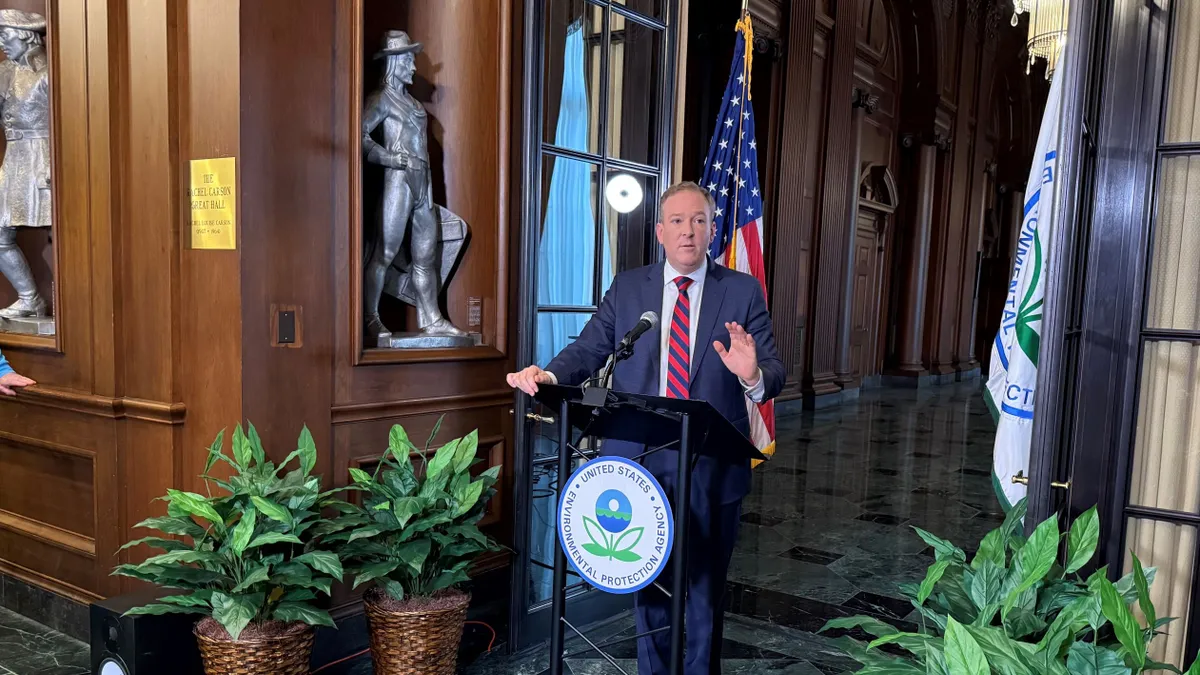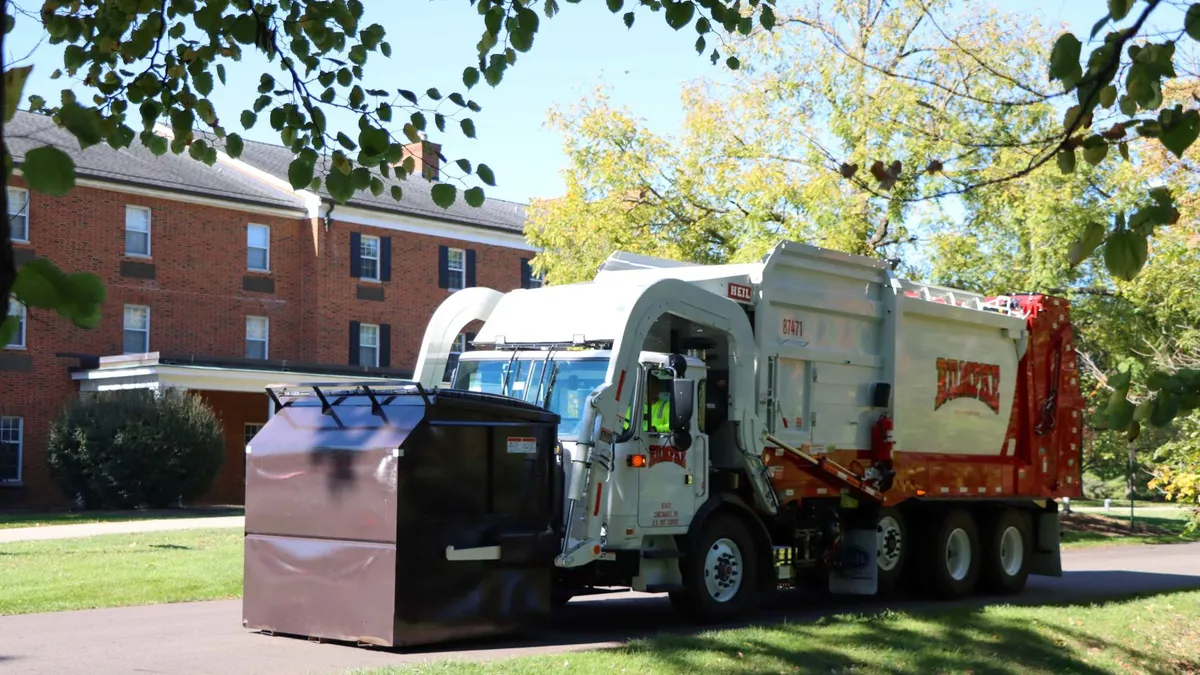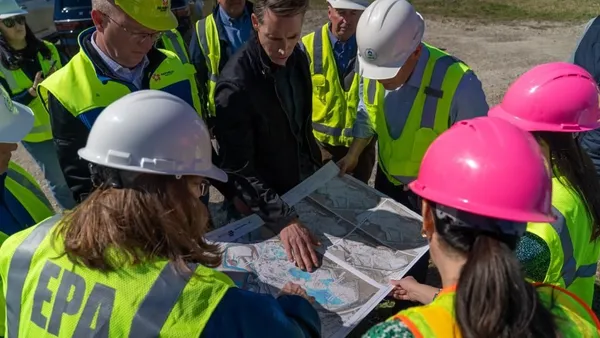Dive Brief:
- U.S. EPA Administrator Lee Zeldin hinted that the agency could make several announcements on PFAS-related regulations in “coming weeks,” during a press conference on Monday. Zeldin did not name specific regulations or issues that could be part of a future announcement.
- During the press conference, he mentioned that the agency has been talking with members of Congress about the potential impact of the EPA’s designation of certain per- and polyfluoroalkyl substances as hazardous substances under the Comprehensive Environmental Response, Compensation and Liability Act. The National Waste & Recycling Association and other groups sued the EPA last year over the matter.
- Separately, Zeldin said the EPA is reviewing concerns from water utilities about how to meet upcoming deadlines for complying with PFAS drinking water regulations. He also confirmed that the EPA will continue working on PFAS-related research.
Dive Insight:
The waste industry has been closely watching the EPA under the new administration for signs that it could roll back, change or delay regulations that could affect industry operations. Such updates may influence how waste operators budget for or manage PFAS mitigation efforts.
Zeldin said the agency has had numerous conversations on how to address PFAS regulations, some of which were put into place during the Biden administration.
“My goal over the course of the next few weeks is to finalize as much of a first plan as possible,” he said, adding that the EPA will need to coordinate among its offices, including the Office of Water, Office of Chemical Safety and Pollution Prevention and Office of Land and Emergency Management.
Though Zeldin did not offer details on what that plan could look like, he noted that PFAS issues are “something that's been important to me for a long time.” When he was a Republican representative from New York, Zeldin supported legislation that would have regulated certain PFAS under the National Drinking Water Standard, and he served on a PFAS task force.
The waste industry has long asked to be exempt from the agency’s final hazardous substance designation for PFOS and PFOA. Industry operators see themselves as “passive receivers” of PFAS and believe that the hazardous substance designation under CERCLA will unfairly open them up to expensive liability issues.
The EPA has previously noted the hazardous substance designation was meant to hold polluters accountable for cleaning up certain PFAS and does not intend to pursue enforcement at some landfill entities. Yet industry groups like NWRA say the wording is not specific enough to protect them from potential negative impacts.
NWRA and the other groups first filed their lawsuit on June 10, 2024, in the U.S. Court of Appeals for the D.C. Circuit. A judge is expected to take the case up again on Friday.
When asked about the CERCLA issue, Zeldin said he understands the industry’s concerns and that Congress has heard from both waste groups and municipal wastewater treatment facilities.
“They’re concerned about having to foot the bill and then pass it on to their consumers, which goes against the principle of ‘polluter pays,’” he said. “I disagree with the concept that an American has to pay to clean up PFAS from their own waterway.”
Water utilities have also expressed concerns about how to meet upcoming deadlines to comply with the PFAS drinking water rule issued last year, he said. The EPA is still in the process of determining how to address those concerns, but could announce decisions “in the weeks coming up.”
Drinking water standards are relevant to the waste industry because many landfill operators send their leachate to water treatment facilities that will be affected by the standards.
Zeldin said local public water systems are worried about upcoming compliance deadlines and the costs related to updating infrastructure necessary to meet the drinking water standards. “We're going to review these pleas, one at a time,” he said.
Under the rule, public water systems must monitor for six types of PFAS and complete initial monitoring by 2027, among other requirements. By 2029, public water systems will need to find ways to reduce these PFAS if monitoring shows that PFAS levels exceed the maximum contaminant level.
The EPA is also facing litigation over the drinking water rules. The American Water Works Association and Association of Metropolitan Water agencies sued the agency last year, saying the EPA did not use the most up-to-date data when crafting the standard and raised questions over whether the rule was consistent with the Safe Drinking Water Act. A federal court is expected to take up the case again by May 12.
Zeldin said decisions related to the lawsuit, expected in the coming weeks, will help the agency determine “what we are looking to do, what we could do, what we will do.”
Zeldin also noted that PFAS research will continue to be “important” to the agency. He did not indicate which PFAS-related research programs or efforts would continue, but said many questions about PFAS are still up in the air and more science on the matter will help drive better decision-making.
“If science related to PFAS has shown us anything, it’s that we need to continue to research PFAS,” both within the EPA and at labs outside EPA jurisdiction, he said.














